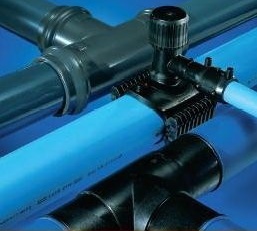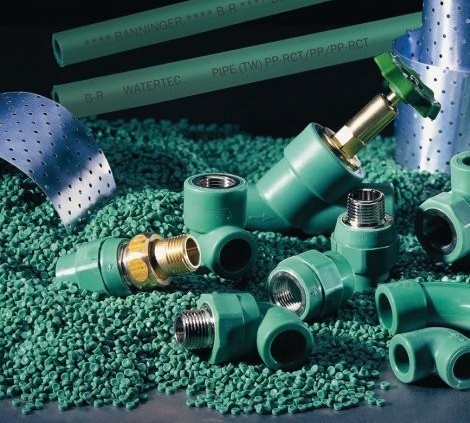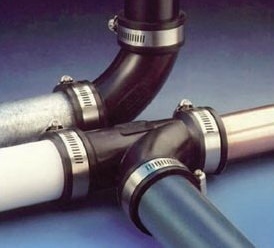How to work with plastic pipes: an overview of joining methods and bending methods
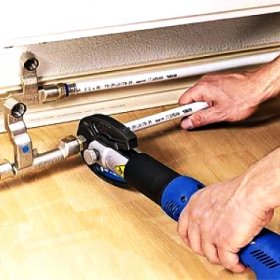
A variety of pipes for heating and water supply makes you think about their choice. Especially if the work is done independently. But this is only the first stage of the installation process of the highway. Often people who are engaged in self-repair have questions about working with plastic pipes. Each pipeline has its own nuances and assembly rules. When installing metal-plastic pipes with your own hands, you need to know the features of their connection and fastening. Indeed, the reliability of a heating or water main depends in many respects on the observance of technology and the quality of work performed.
Content
Features of the connection of plastic pipes
General information about plastic pipes in the domestic market:
Fittings are used to connect plastic pipes. They are installed in order to make a turn or branch of the highway or as a connection of pipes of different diameters. Depending on the fittings that will be used, the connection of metal-plastic pipes is carried out either using crimping nuts or using a press. Please note that hidden pipe laying is only permissible when using press fittings. In other cases, the junction should have free access.
Tools required for work:
- Pipe cutter. The use of other improvised tools leads to the formation of barbs, violation of the protective coating of the product or uneven cut.
- Calibrator and foskosnimatel. They help to give the cut the desired shape and flare the pipe so that the seals do not deform.
- Adjustable wrenches or spanners for compression fittings
- Pipe clamp pliers using press fittings. Using an electric tool makes the process easier.
Preparation of plastic pipes before connecting them together is the same for any option. Having measured the necessary segment of the product, they trim precisely at right angles. Pipe measurements must be made taking into account the length included in the fitting. If, at the same time, the pipe is deformed, it must be leveled using a calibrator. With its help, the inner chamfer is removed from the end of the product. The outer one is removed with a chamfer. The tool must be selected depending on the size of the pipes. Further, depending on the connection method.
Option # 1 - Compression Fittings
Before using collet fittings, make sure that there are o-rings on the product shank and dielectric gaskets. Then tighten the nut on the end of the pipe. Then put on a crimp ring. In the case of using a crimp ring in the shape of a cone, they begin to put it on the pipe from the narrower side.
Then insert the shank of the part into the pipe with a little effort. To seal the connection use tow or flax with sealant. Put the union nut on the fitting body and tighten. It is advisable to use 2 wrenches, one of which helps to tighten the nut when the second fixes the part body. When tightening the union nut, adjust the pressure so that the part does not crack.
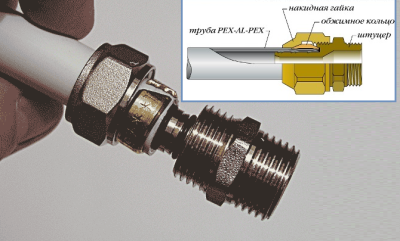
Before putting the compression fitting on the metal-plastic pipe, it is necessary to check the presence of sealing rubber bands, dielectric gaskets and their integrity
Advantages of the connection:
- ease of installation;
- no need to use expensive equipment;
- reusability.
Disadvantages:
- installation takes a lot of time;
- connection using collet fittings Do not walled in the walls;
- Periodic connection check required.
Before putting on the press fitting, it is necessary to remove the sleeve and check the presence of gaskets and gaskets. After that, the shank of the part is put on the end of the pipe, with little effort. At the same time, the pipe should be visible in the control windows of the fitting. Note that the edge of the pipe inserted into the fitting should fit evenly around the part around the perimeter. Otherwise, you will have to cut it again, otherwise the connection will be unreliable.
How to prepare press tongs for working with plastic pipes? Before use, the tool handles must be rotated 180 ° and insert the inserts corresponding to the size of the pipe. Closing the handles, check the correct position of the liners. Having opened the tool, insert the end of the pipe with the fitting and close the handles all the way. One-piece connection is ready. Do not crimp press pliers again. The locking of the tool handles must be performed once.
How to use the electric press, you can watch the video:
Advantages of the connection:
- the connection is reliable and durable;
- regular check is not required;
- the connection can be “hidden” in the wall and used to install a “warm floor”.
Disadvantages:
- requires a special and expensive tool for pressing and experience with it;
- poorly executed connection may leak;
- inability to reuse.
About the choice of press fittings for plastic pipes read in our article:https://aquatech.tomathouse.com/en/uchebnik/truby/press-fitingi-dlya-metalloplastikovyx-trub.html.
Option # 2 - push fittings
No additional tool is needed to connect the pipes using push fittings. To connect the pipe is inserted into the push fitting until it stops. In this case, the end of the pipe should be visible in the inspection window. After connecting the entire line, water is connected. In this case, the fitting wedge is pushed and clamped, which prevents leakage.
Advantages:
- ease and speed of use;
- no additional tools are needed for work;
- one-piece connection;
- durability;
- suitable for bricking
- the finished connection can be rotated.
Disadvantages:
- the high cost of push fittings;
- Shutter speed after installation of three hours is required.
You can watch more details about this type of fittings in the video:
Option # 3 - Collet Fittings
The connection of pipes from different materials is carried out using a collet fitting. If the pipes are of different sizes, then the thread of the part should correspond to the metal product, and the remaining components of the pipe made of metal plastic.
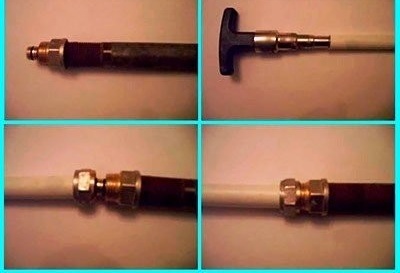
For pipes of different diameters, a fitting corresponding to the size of the metal-plastic pipe is taken except for the threaded part. It is matched to the size of the metal pipe.
A fitting is put on a metal pipe, wrapping it to start tow. A nut and washer are put on the edge of the prepared metal-plastic pipe. Then connect them together and tighten the nut.
In some cases, plastic pipes are used for the installation of heating systems. You will learn about the pros and cons of these and other types of pipes in our material:https://aquatech.tomathouse.com/en/uchebnik/truby/kakie-truby-dlya-otopleniya-luchshe-vybrat.html.
Fixing plastic pipes to the surface
When working with metal-plastic pipes, you need to know how to mount them to the surface. To fix the pipes, you must use special clips. They are selected taking into account the size of the pipe itself. First you need to install the clip. Its fastening is carried out using self-tapping screws or dowels. To avoid sagging trunk, the distance between adjacent clips should not exceed one meter. The bending points of the pipe must be fixed on both sides.
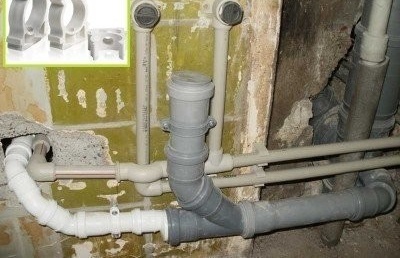
To avoid sagging piping, the distance between adjacent clips should not exceed 1 meter. Turn of the highway in the corner of the room should be fixed on both sides
How to bend a metal-plastic pipe?
The advantage of metal-plastic pipes, among other things, is the ability to bend them in the right place. This helps reduce the number of fittings used. This feature is used when necessary to make a turn and the arrangement of warm floors. There are 4 ways to bend a metal-plastic pipe:
- hands;
- spring;
- with a hairdryer;
- pipe bender.
Option # 1 - bending pipes by hand
This method requires dexterous hands. To learn how to bend a pipe without any devices, see the video instruction:
Option # 2 - the spring will help to avoid defects
There is a spring on sale specifically designed for bending pipes. It is inserted into the product. After that, bending is done with ease and without defects. The size of the spring is selected according to the size of the pipes.
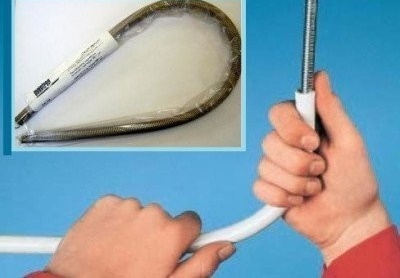
Using a spring to bend metal pipes helps to avoid defects and damage to the product. The size of the spring must match the size of the pipe.
Option # 3 - use a building hair dryer
Plastic pipes under the influence of heat become more pliable. To heat them use a building hair dryer. Only this must be done carefully so as not to overheat the plastic. After heating, the pipe bends in one motion.
Option # 4 - pipe bender for the master
And yet, if you are a beginner master with no work experience, it is better to use special pipe bender. It will help to bend metal-plastic pipe of any size without much effort. On sale there is a pipe bender crossbow. To use it, it is enough to set the bend angle, insert the pipe and reduce the handles.
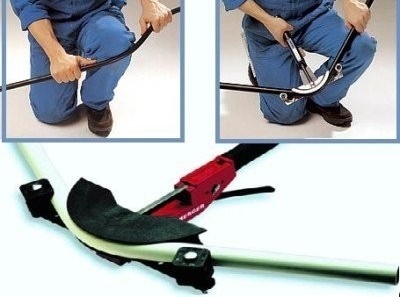
If you do not have experience with metal-plastic pipes, it is better to use a pipe bender. A special pipe bender helps to bend the pipe at the right angle
Find out what advantages a metal-plastic pipe has, and whether it can be chosen for installation of a warm floor:https://aquatech.tomathouse.com/en/otoplenie/teplyj-pol/truby-dlya-vodyanogo-teplogo-pola.html.
It is clear that without efforts to make high-quality plumbing or heating will not work. Any work that you will perform with metal-plastic pipes, from the selection of the product to the verification of the capacity of the system, must be treated responsibly. Only in this case can the durability of the water supply or heating main be guaranteed.
